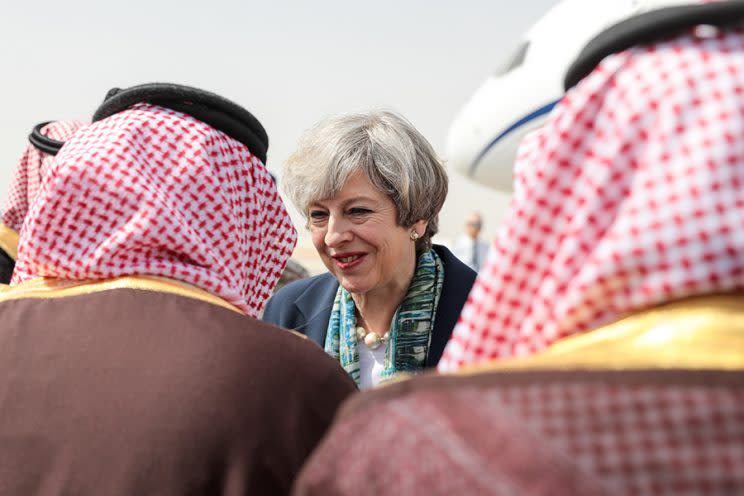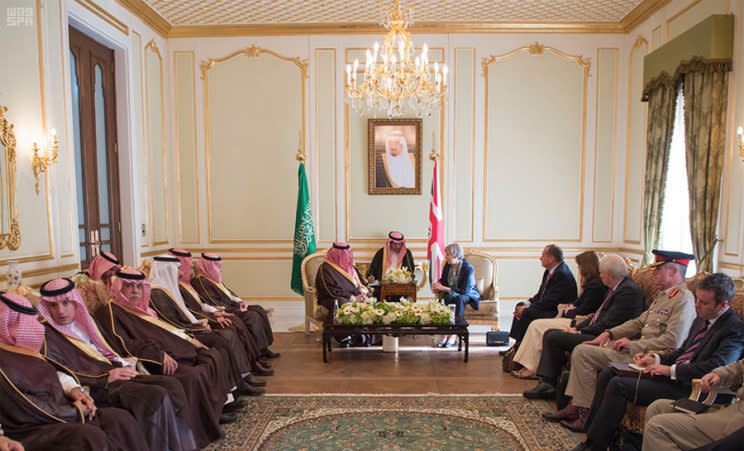Should Theresa May Be Wearing a Headscarf in Saudi Arabia?

British Prime Minister Theresa May caused a stir on Tuesday when she visited Saudi Arabia — not only for setting foot in the country to begin with, but, perhaps even more so, for flouting the dress code for women by not wearing a headscarf.
“It’s important for me as a woman leader and as leader of the government of the United Kingdom to maintain the relationships that are important to us as a country, for our security and our trade for the future,” May said regarding her decision to visit the Arab nation. “But I hope also that people see me as a woman leader, will see what women can achieve and how women can be in significant positions.”
Photos of May stepping out of her plane with her head uncovered sparked immediate reaction, both in the press and on Twitter. The Telegraph noted that May “has taken a stand against Saudi Arabia’s ultra-conservative regime by not wearing a headscarf — going against official Foreign Office advice,” and a flood of tweets praised the British leader for the move, though many came tinged with anti-Muslim sentiment as well.
@FoxNews And why wouldn’t she? Not her culture. To expect otherwise would be like her expecting them to come to the UK without headscarves.
— Cindy Wells (@realCindyWells) April 4, 2017
@FoxNews Our PM is not muslim
So why she has to wear that rubbish ?
Do they take off their rubbish when they visit the UK ?— SAM (@SAM2898GG) April 4, 2017
@Telegraph @RedHotSquirrel Well done Theresa May for not wearing a headscarf ,not submitting to an evil ideology.
— Thomas (@tfowkes02) April 4, 2017
Still others believed the move was disrespectful:
@theresa_may Stupid woman – if we want Saudis to respect our values and traditions, we should respect theirs https://t.co/ZR58jaNyFK
— Sleep Deprived (@xtrand) April 4, 2017
Theresa may takes stand by not wearing head scarf, shes such a donut shes just being disrespectful to religion ????????
— Mike Donno (@BBUKMIKE) April 4, 2017
May is not the first leader to flout headscarf rules during visits to Muslim nations, as France’s far-right candidate Marine Le Pen did the same during a trip to Lebanon in February, and women including Hillary Clinton and Michelle Obama chose to show their heads during trips to Saudi Arabia.

Before her visit on Tuesday, May had said she hoped to be an inspiration to oppressed women in Saudi Arabia by showing people there “what women can achieve.”
But that sort of statement, particularly if conflated with the issue of the Muslim headscarf, notes Asma Uddin, director of strategy for the Center for Islam and Religious Freedom in Washington, is “problematic.” That’s because the notion, Uddin tells Yahoo Beauty, “assumes that the headscarf is necessarily a tool of oppression and that women wear it out of coercion.” The idea of swooping into Saudi Arabia as an example of freedom and success, she says, “absolutely seems condescending.”
What many non-Islamic women may not understand about the headscarf, Uddin explains, is that “there are so many women who wear it voluntarily,” and that many of them, particularly those of the younger generation, “may see it as a source of empowerment” and a political statement that “is pushing back against the rhetoric, no matter which side it’s coming from,” that “anything related to Islam is categorically oppressive.”
Indeed, more and more Muslim women have begun to speak out about how there is more than one way to be feminist, and that wearing a headscarf, or hijab, can be stylish, beautiful, and empowering.
“There is much misunderstanding about how women relate to their hijab. Some, of course, choose the head cover for religious reasons, others for culture or even fashion,” wrote Nadiya Takolia in an opinion piece for the Guardian. “But in a society where a woman’s value seems focused on her sexual charms, some wear it explicitly as a feminist statement asserting an alternative mode of female empowerment. Politics, not religion, is the motivator here. I am one of these women.”
More recently, Dalia Mogahed, director of research at the Institute for Social Policy and Understanding, a nonprofit organization working to empower American Muslims, told USA Today that while some countries do require a hijab, “the ‘hijab oppresses women’ narrative is not only racist, it is also sexist.”
Still, among Muslim women, there are myriad opinions on the headscarf and its meaning. Masih Alinejad, an Iranian journalist and anti-hijab activist with a massive social media following, may find power in May’s message, if her past comments are any indication. “There are a lot of brave women inside Iran, and they wanted to say ‘no’ to compulsory hijab,” she said recently. Alinejad added, “This is not an internal matter. This is the time for all women around the world who visit Iran to stand with us.”
Still, for Uddin, it’s May’s narrative of showing women what they can achieve that colored her view of May going scarf-free — not the action itself. “It’s more so the statement,” she says. “So it’s not that she’s not wearing a headscarf, but how she’s framing it.”
Read more from Yahoo Style + Beauty:
Follow us on Instagram, Facebook, and Pinterest for nonstop inspiration delivered fresh to your feed, every day. For Twitter updates, follow @YahooStyle and @YahooBeauty.


